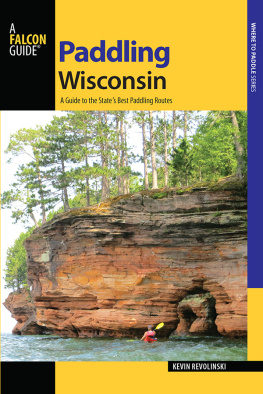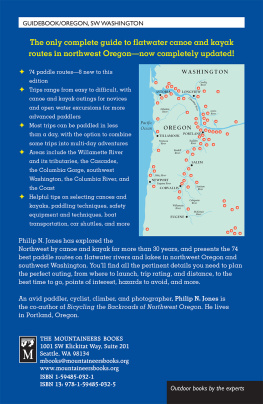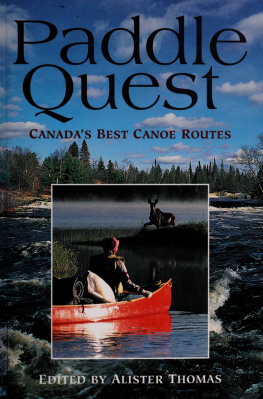CREATING A PACKING LIST
Its one thing to plan your trip, but its another to prepare and pack for it, and how and what you pack will determine how enjoyable your experience will be. Before you go, youll need to organize and pack three basic types of equipment; paddling gear, camping gear, and personal gear, and it all needs to be organized and accounted for before you step off into the wild. These are what our lists look like.
PACKS, BAGS, AND SOMETIMES BOXES
A trip on the water involves the possibility that everything you pack will at some point get wet, making the bags, packs, and containers you choose to take, of special importance. You will also need to balance two competing requirements when packing: keeping things dry and your ability to carry your gear around unnavigable sections of the trailportaging as its called, from one place to another.
Our canoe on the Allagash loaded with gear; three drybags with camera gear in the bow, camera in waterproof case on the seat along with one-man tent; center section holds my day pack, Erics black canoe pack, and my Kelty backpack; aft section contains our yellow wannigan, waterproof drone pack, map case, and 5-gallon waterproof bucket.
I own a large seventies era Kelty Backpack with an external frame thats the best pack Ive ever owned, but its not a pack I usually bring on a canoe trip. Its too rigid, the external frame is problematic because it doesnt pack well in a canoe, and its almost impossible to access when secured for water travel. Instead, Eric and I each bring two packs; a small daypack stocked with items we may need to access while canoeing, and a large frameless pack commonly referred to as a canoe pack. Canoe packs come in a variety of sizes from 45 to 120 liters. We prefer one that ranges between 80 and 100. Canoe packs are not waterproof, and youll need to double bag your gear with trash bags; If you dont trust that method, youll need to use drybags. Drybags come in a variety of sizes but be careful how many you bring because theyre usually bulky, dont pack well, and although some come with pack straps, youll need to decide how many portaging trips youre willing to make to move your gear from one point to another. I use heavy duty drybags for my camera gear and make sure when I seal them, I leave a good amount of air in the bag. I also wrap the cameras in towels for protection. It makes for a bulky mess at times, but at least the bags will float if they go overboard. If were particularly concerned about our cameras, we sometimes pack them in a large Pelican case but only include that when we know we wont be portaging any great distance. When you portage with that kind of case, its problematic; theyre large, very heavy by design and awkward to carry, besides that; you look like a door-to-door salesman who wandered off and got lost in the woods. When we take along our drone, we pack it in a heavy-duty waterproof hard-box and place that case into a waterproof backpack; its the one piece of camera equipment not covered by our insurance policy, so we take extra precautions. We like to use lightweight compression bags for things like clothing, sleeping bags, and anything else compressible. When we know well be portaging on a trip, we pack as much equipment and gear as possible in our canoe packs; the less upside-down canoeing between waterbodies the better.
On any canoe trip lasting more than two days we bring a wannigan; a storage box and traditional piece of canoeing equipment, its name, derived from the Ojibwa word waanikaan, means storage pit, its purpose is to carry all those hard to pack items needed on a trip. Traditionally wannigans were constructed of wood and fancy ones would even conform to the canoes curves. Our wannigan is plastic with a sealable lid.
Many have a tumplinea strap allowing the carrier to use his head to support most of the weight. Our box doesnt have a tumpline; my neck having suffered enough abuse over the years, I dont need to contribute to the damage by carrying a 30-pound box around by my head. Id be more than happy to install a tumpline if I could get Eric to carry it, but he keeps telling me his mother didnt raise any fools, so we have lines attached to both sides of the box allowing us to carry the box with a pole or do a simple two-man carry. Sometimes a wannigan will be fitted out with straps allowing the use of a pack platform to aid in carrying with or without a tumpline.
CANOES AND KAYAKS
Youll need a boat! The general rule is a canoe or kayak, although some of the trail can be visited in almost anything that will float. We used several canoes depending on how much gear we needed to take, what type of paddling we thought wed encounter, and how long we expected to be on the water. Our number one is a 16-foot Old Town Discovery 169. The Old Town is a very good river canoe, tracks well in whitewater and is a workhorse when it comes to the amount of gear it can hold. We also used a Mad River 14-foot Adventure canoe. This canoe tracks well because of its modified keel and we used it mostly for day tripping because of its limited weight carrying capacity.








